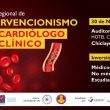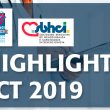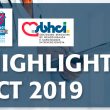On November 30, 2019, the “I Regional Course of Interventionism for the Clinical Cardiologist” will take place in Chiclayo, Peru. The event will be held in the Muchick Room at Costa del Sol Hotel, organized by the Peruvian Society of Hemodynamics and Endovascular Interventionism (SOPHIE) with the support of SOLACI. The activity will be oriented to<a href="https://solaci.org/en/2019/11/13/regional-course-of-interventionism-for-the-clinical-cardiologist-with-solacis-support/" title="Read more" >...</a>
The Most Read Scientific Articles of October in Interventional Cardiology
1- Incidence and Prognosis of Heart Valve Embolization The incidence of peri-procedural transcatheter heart valve embolization and migration (TVEM) is as low as 1%. However, it is associated with increased morbidity and mortality. Read more HERE 2- 1000 MitraClips: Results from the World’s Most Experienced Site In September 2008, interventional physicians at the Heart and<a href="https://solaci.org/en/2019/11/07/the-most-read-scientific-articles-of-october-in-interventional-cardiology/" title="Read more" >...</a>
iFR or FFR Measurements by Sex: Is Either One More Adequate?
According to the post hoc analysis of the DEFINE-FLAIR, patient sex seems to affect instantaneous wave-free ratio (iFR) and fractional flow reserve (FFR) guided revascularization outcomes. Even though this is not specified in the study protocols, it might affect the gold standard for functional lesion assessment. However, clinical outcomes are similar with both strategies. Therefore,<a href="https://solaci.org/en/2019/11/04/ifr-or-ffr-measurements-by-sex-is-either-one-more-adequate/" title="Read more" >...</a>
MIDAS Strategy: Minimizing Implantat Depth According to Membranous Septum
Permanent pacemaker implantation following transcatheter aortic valve replacement (TAVR) continues to be one of the most frequent complications. Even though its real impact on prognosis continues to be controversial, its impact on healthcare cost is out of the question, in addition to being uncomfortable for patients. This study, soon to be published in J Am<a href="https://solaci.org/en/2019/10/18/midas-strategy-minimizing-implantat-depth-according-to-membranous-septum/" title="Read more" >...</a>
TCT 2019 | PCI in Stable CAD. Prior TAVR, with TAVR or Never?
Courtesy of SBHCI. This interesting study presented at TCT 2019 and simultaneously published in Am J Cardiol tells us PCI in stable coronary artery disease cannot lower risk in patients with severe aortic stenosis undergoing transcatheter aortic valve replacement (TAVR). Unless patients are symptomatic, most coronary artery lesions do not need revascularization according to researchers.<a href="https://solaci.org/en/2019/10/10/tct-2019-pci-in-stable-cad-prior-tavr-with-tavr-or-never/" title="Read more" >...</a>
TCT 2019 | FORZA: OCT vs FFR to Define Intermediate Lesions: Anatomy or Function?
Courtesy of SBHCI. Both fractional flow reserve (FFR) and optimal coherence tomography (OCT) can be useful to help define intermediate coronary lesions and optimize PCI outcomes. The FORZA study presented at San Francisco TCT 2019 scientific sessions simultaneously published in JACC randomized patients with intermediate lesions 1:1 to FFR vs OCT. For the FFR arm,<a href="https://solaci.org/en/2019/10/01/tct-2019-forza-oct-vs-ffr-to-define-intermediate-lesions-anatomy-or-function/" title="Read more" >...</a>
TCT 2019 | PARTNER 3: Obvious Short-Term Quality of Life Improvement, but What Happens Afterwards?
Courtesy of SBHCI. Patients with severe aortic stenosis and low surgical risk showed decreased mortality, stroke, and heart failure hospitalization at one year with transcatheter aortic valve replacement compared with surgery. Improved quality of life may seem an obvious consequence, but until now that was mere speculation. This work, presented at the TCT 2019 Scientific Sessions<a href="https://solaci.org/en/2019/10/01/tct-2019-partner-3-obvious-short-term-quality-of-life-improvement-but-what-happens-afterwards/" title="Read more" >...</a>
TCT 2019 | SCOPE I: Self-Expanding Valve Acurate Neo Head to Head with Sapien 3
Courtesy of SBHCI. This work, which was presented during the TCT 2019 Scientific Sessions and simultaneously published in the Lancet, randomized patients to the ACURATE Neo prosthesis (n = 373) vs. the SAPIEN 3 (n = 367) in a head-to-head comparison involving 20 European sites. Transfemoral access was used in all patients. The study had a noninferiority design, and its primary<a href="https://solaci.org/en/2019/09/30/tct-2019-scope-i-self-expanding-valve-acurate-neo-head-to-head-with-sapien-3/" title="Read more" >...</a>
TCT 2019 | AUGUSTUS ACS: Apixaban vs. Warfarin and Aspirin vs. Placebo in AF and ACS
Courtesy of SBHCI. The safety and efficacy of antithrombotic and antiplatelet treatments in patients with atrial fibrillation admitted with acute coronary syndrome (who receive medical treatment or angioplasty) may vary from that in patients undergoing elective treatment. At 14 days from elective angioplasty or hospitalization due to acute coronary syndrome, patients were randomized in a 2×2<a href="https://solaci.org/en/2019/09/30/tct-2019-augustus-acs-apixaban-vs-warfarin-and-aspirin-vs-placebo-in-af-and-acs/" title="Read more" >...</a>
TAVR and Pacemakers, New Strategies
Courtesy of Dr. Carlos Fava. TAVR has been shown beneficial and is constantly being advanced onto lower risk populations, but at present, it is limited (perhaps most importantly in aortic tricuspid valves) by the need for permanent pacemaker implantation (PPMI), especially when it comes to self-expandable valves, as the latest study on low risk populations<a href="https://solaci.org/en/2019/09/30/tavr-and-pacemakers-new-strategies/" title="Read more" >...</a>






